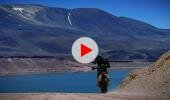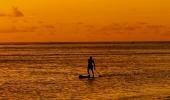Words & Video: Steven Yates | Photos: Steven & Laura Yates
Thailand is renowned for many things and the magnificent clear, warm, blue sea is definitely near the top of the list. The most commonly dived areas off Thailand are those accessible from the main land based resorts, such as Ko Samui on the east coast and Hin Daeng on the west coast. Laura and I decided to venture a little further into the majestic blue and boarded the Sampai Jumpa, and headed for the islands off the west coast of Thailand in the Andaman Sea, just south of Myanmar, known as the Surin and Similans.
The Sampai Jumpa is a beautiful wooden gaff-rigged Phinisi yacht with a capacity of only 11 divers, which makes for a very intimate and customised live-a-board experience. We were even luckier, with only four other divers joining Laura and myself the staff focused on making sure we had the most wonderful experience. In comparison to other live-a-boards the Sampai Jumpa was very basic and without all the high technological innovations of the modern world. For me this was excellent as the trip was about diving, and with four dives a day for six days I was happy to leave the world of computers and DVDs behind me. Before I get to the diving, it is critical to mention - as is the case with most live-a-boards - the amazing food. We were fed relentlessly with five meals a day of the most magnificent combinations of Western and traditional Thai food.
The diving was beyond magnificent. The water temperature was a gorgeous twenty-seven degrees, which meant diving in a shorty was ideal. The average visibility was 40 metres and then some in all directions, with the water being a crisp, clean blue. We were exceptionally lucky in that we had very little current for the majority of our trip and could quietly drift across the coral gardens and enjoy the splendour of the area. The dive sites are quite distinct in that those on the eastern shores tend to be gentle sloping coral gardens and sandy patches. The western coast is quite different with its dramatic rocky structures, walls, and excellent swim-throughs.
Some definite highlights include:
• Elephant Head Rock is an amazing exploration of big granite boulders and a matrix of swim-throughs. We were really fortunate to have very little current on this dive because the site is renowned for some pretty whirlpool-like effects as the Andaman pushes into the western coast of Similan 8.
• East of Eden was diametrically opposite from Elephants Head Rock and resembled an aquarium more than a dive site. Located just off Similan 7, East of Eden gave us a great view of the wonderful results of the turtle hatching programme run in the reserve, with a multitude of excellent sightings. The reef life was some of the best I have seen and the colourful feather stars and Christmas tree worms augmented the myriad of coral.
• Night Dives were also a real highlight, the most memorable being a super dive in Honeymoon Bay. The life of a night dive is so different to that of the day and seeing active cowry shells, hunting octopus, and trevally were a special treat. Some eerie dark swim-throughs were accentuated with long, wrecked remains of ghostly ships. A beautifully preserved anchor hung suspended by its stocks across a narrow swim-through providing a silent reminder of the sea's power.
• Underwater Tsunami Monument is an amazing experience. Ten metres below the waves you will find a number of monuments that have been sunk in memory of the devastation inflicted by the 2004 tsunami. The monuments are representations of the zodiac signs, as well as a memorial temple and a woman resting in the sand. The memorial has also provided a home for a whole new colony of reef fish and was a real highlight for me.
• Richelieu Rock, some fifty nautical miles north of Similan, off the island of Surin, is still encapsulated in the national park, but due to its remote location it is often not accessible by the six-day live-a-boards. The dive site is huge and the reef breaks the surface at low tide, providing a very impressive home to massive schools of fusiliers, trevally, and chevron barracuda. The macro life was equally impressive with anglerfish, and my very first seahorse was another highlight.
With those beautiful sites singled out, it must be said that all the diving merged into one long six-day dive, with close encounters with leopard sharks, white tips, eels, turtles, Napoleon rass, squid, octopus, ornate ghost pipefish, cuttlefish and much, much more. The ultimate highlight though was my very first manta ray. We were diving along a wall with our heads stuck in the rocks looking for interesting critters when - by chance - I turned to gaze out into the deep blue, only to have a huge manta swim right alongside me. I started screaming into my regulator and pulling on Laura’s arm, kicking the instructor's head … not very master diver like at all, but then it was my first manta and it had taken me more than 200 dives to see it - I was pretty excited. Unfortunately, my antics meant that the ray did not hang around for long, but it did not matter as I was on cloud nine.
The underwater vistas were not the only beautiful sights served up by the Andaman Sea islands. Dropping anchor on a clear afternoon in Honeymoon Bay we skipped our afternoon dive for a walk across the picturesque beach cove and up through a rocky outcrop, up a chain ladder and onto a rock plateau majestically perched high on the island, which provided a 360 degree view of the awesome surroundings. The Sampai Jumpa bobbed happily in the bay below as the wonderful crew prepared our gear for a night dive, while we gazed across the azure waters and wondered at what hidden treasures we had yet to uncover.
All in all, Thailand’s best dive location provided us with one of the finest examples of this wonderful world.
dinFO:
• Worldwide Dive and Sail operates a very professional diving live-a-board operation, which services the whole of South East Asia. At the time of writing, the Thailand trips had been removed from the roster.
• The Similan Islands consist of nine islands that are referred to as Similan 1 through to Similan 9, a reference when marking dive sites. Islands 1, 2, and 3 are closed to the public as part of a turtle protection and hatching programme.
• The word Similan is actually a Thai word meaning 'nine'.
• The Similan National Park was established in 1982.










